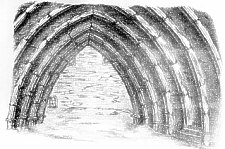
Until the late 18th century there were two authorities that could imprison offenders - the Ecclesiastical Court under the Bishop and the Civil Courts under the Governor. Both authorities had their own prisons,

This was the crypt under old St. German's Cathedral on St. Patrick's Island - it was well described by Harrison in Manx Soc Vol 29 - many offenders against the Ecclesiastical Laws were confined here from at least the 15th century till as late as 1780. Examples of such commitments can be seen in the Archdiaconal records though it would appear that many managed to commute the sentence for money or good deeds. In 1698 Bishop Bridgeman confined his own sergeant of Barony Lands to the prison for what appears to be financial irregularities; even Bishop Wilson consigned many to his prison both for immoral activities and also for non payment of tithes. Hannah Bullock writing in 1816 states: "Indeed, the power of the clergy in the Isle of Man has always had an arbitrary character, and even to this day the sentence of the bishop, or vicars general, is decisive, nor does it admit of bail; there is no alternative between prompt submission or imprisonment."
The main place of confinement was the keep of Castle Rushen (what is today sometimes shown as a 'dungeon' is in fact the old tidal mill); Train describes it as containing dark and dismal cells. Bishop Wilson was confined in the Castle for some months during his dispute with Governor Horne and as a a result suffered badly from rheumatism in his hands.
Denton describes the court system in 1681 - apparently those indicted by a jury of inquiry (of 6 men) were bailed to appear at the next Court hearings (every 6 months) at Castle Rushen where the courthouse, prison and gibbet were - he also comments that many were sentenced to transportation. Besides criminal cases a major class of prisoners were debtors - especially non-natives who were thought more likely to escape the Island - the Act of 1777 required that such debtors be allocated 6d a day for food and necessities.
In 1791 the then gaoler (and Chief Constable of Castletown - a job approximately equal to that of a Police Sergeant ) complained of the poor salary and working conditions (neither they nor salary had improved by 1806!). That conditions had deteriorated since 1765 is confirmed by the evidence of Deemster Thomas Moore.
That there were in 1765, within the castle of Rushen, distinct places of confinement for debtors and for criminals, roofed in, and defended from the inclemencies of the weather ; that there were then three rooms made use of for the confinement of debtors, one of which is now used as an armory, the other as a guard-room ; and the last, which is the smallest and most inconvenient of the three, is the only place in which debtors are now confined.
A letter from Governor Dawson in 1781 stated that post 1765 " for many years the unfortunate prisoners were kept alive only by the benevolence of the Governor and some members of the public."
In 1815 the Castle was remodelled to better act as a prison both for debtors as well as criminals - it also served as a place of confinement for lunatics. In 1843 an escape, from what appeared a barely secure establishment, provoked a commission of inquiry whose report gives a good description. Some of the problems were attacked in an 1846 Act of Tynwald - which imposed on the gaoler the duty of keeping a daily journal which can provide fascinating sidelights on both working conditions, staff and prisoners.
Further condemnation was given in 1886, money for a new prison (in Douglas) was allocated in 1887 and the new prison opened in 1891 allowing Castle Rushen to be restored to its pre 1815 days though it seemed to remain as Castle Rushen Military Prison for some years afterwards (see entry in Brown's 1894 Directory)
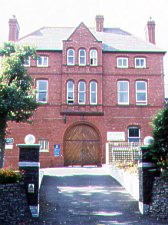
IoM Prison - Marathon Road, Douglas
Other places of confinement were associated with the courthouses in Douglas, Peel Ramsey and Kirk Michael though it would appear that those for Douglas and Ramsey were initially established in 1757 as part of the strengthening of the forts at the harbours..
In 1792 Thomas Whitham, chief constable of Douglas, stated:
That the prison at Douglas is for the confinement of persons guilty of felony, or breach of the peace, and was formerly made use of for that purpose ; but is at present in a very ruinous condition, and insufficient for the purpose of confining offenders, without having a guard set over them.
This prison was a room at the base of the civil war fort on the rocks at the end of today's Fort Street, demolished in 1819 - at one time it was known as Paul Bridson's Parlour - Paul Bridson being both town captain and customs officer for Duke of Athol, it was staffed by a small garrison.

From Feltham (Manx Soc vol
6)
Feltham describes it as "the only place of confinement for common offences. The inhabitants in turn are summoned to keep watch and ward to prevent escapes. A proper place of confinement should be among the first objects of the new improvements for public safety."
For many years the main courthouse was within Castle Rushen though lesser courts (including Ecclesiastical courts) were established in all the main towns - new buildings were erected in Douglas and Ramsey at the end of the 18th century. During the mid 19th century, as part of the growing influence of Douglas the high courts were transferred, initially temporarily, to Douglas, and suitable premises were required as that on the pier was dilapidated.
In 1792 Governor Shaw described the state of Courthouses and Prisons on the Island as truly deplorable.
A new courthouse, close to the entrance of the Red Pier was constructed c.1795, to a design of George Steuart which also contained cells - this may have been the place referred to as 'nine holes'.

Old Courthouse (now demolished) on Pier, Douglas
When the Oddfellow's Hall was acquired and turned into the main courthouse this building was no longer required - occupying a key position at the end of the pier it was acquired by Samuel Harris, High Bailiff, pulled down and the Imperial Hotel constructed on its site. The watch-house however survived as a detached building, an upper floor was added but the original form can still be made out standing rather isolated at the entrance to the greatly altered pier.

Athol Street Courthouse, Douglas
The Oddfellows' Hall in Athol Street was acquired and converted to house the courts - a new Courthouse complex was opened in 1997 and the Athol Street building is still awaiting a new use.
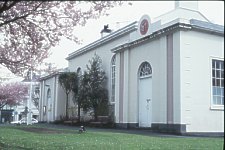
Ramsey Courthouse, 1798
Like Douglas an old building was pressed into service as a gaol - in this case a room at the bottom of the old lighthouse on the pier. Also like Douglas a new courthouse was built as part of the improvements to public buildings - this attractive building, also by Steuart, was opened in 1798 and, judging from his drawing resembles the main part of the Douglas Courthouse.
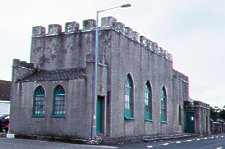
Courthouse, Kirk Michael (now unused)
A courthouse at Kirk Michael was convenient both for the northern parishes but especially for the Bishop who resided at nearby Bishopscourt - the adjacent and aptly named Mitre Inn dates from the mid 18th century and provided refreshment for those appearing at the court. Brett Woods [M.A. thesis to appear] is of opinion that the existing courthouse clearly shows (especially in the windows and crenellations) the hand of Thomas Brine. This is consistent with the date of construction as Oswald's guide of 1831 describes it as 'recently erected' though a court-house was erected by Bishop Hildesley.
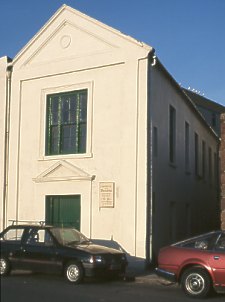
A courthouse was built between Castle Street and the Quay (later a meeting place for Plymouth Brethren and now housing the Leece Museum.) on a long narrow site next to the salt-warehouse (since demolished). Lewis states that the building probably dates from the early part of the 19th century - however Lib Assed describes the plot as of 8d rent in the Lord's hands from at least 1589 (the 1616 roll describes it as house & garden) and as the court house as from at least 1709 - it is likely that the courthouse was built (or the old property converted) c.1693 during the governorship of William Sacheverell.
Judging from the derogatory comments made by Sir James Gell, Attorney-General and echoed by High Bailiff Laughton during the opening of the new court (Peel City Guardian 6 Aug 1893) the legal profession were glad to move - he described the old court house as a 'dreadful space' having no air space and always full of people who had nothing else to do, and if the day were wet there were all the sailors and fishermen ... and the room was not fit to be in.
There was a cell at the basement - apparently dreadful - as part of the improvement in policing a new police station and lockup was built a few yards away from the courthouse.
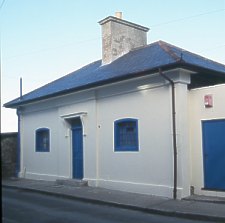
Peel 19th Century Police Station, Crown Street
A new police station was built c.1847 (some refs state 1851 or 1860 though Lewis quotes the drawings as dating from 1846 ), the cells replaced the 'black hole' in the cellar of the courthouse.
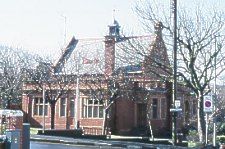
Peel Police station (one time courthouse)
The old courthouse was in turn replaced in 1893 by the courthouse/police station adjacent to the Cathedral, which still acts as a police station though all court functions have now been transferred to Douglas. This was to the design of Langton Dennis, a London Architect - apparently cost cutting required that the building be smaller than desired.
Hampton Creer Never to Return Douglas: Manx Heritage Foundation 2000 (ISBN 0-952-4019-7-5) - includes some
discussion on punishment etc.
N.D. Quilliam Keys and Cuff The Inside Stories self publication(Copy Shop Douglas) 2009 (ISBN 978-0-9564333-0-5)
- some history of the gaols + prison life told by a retired prison officier
|
see D66 |
||
|
|
||
|
Any comments, errors or omissions
gratefully received The
Editor |
||